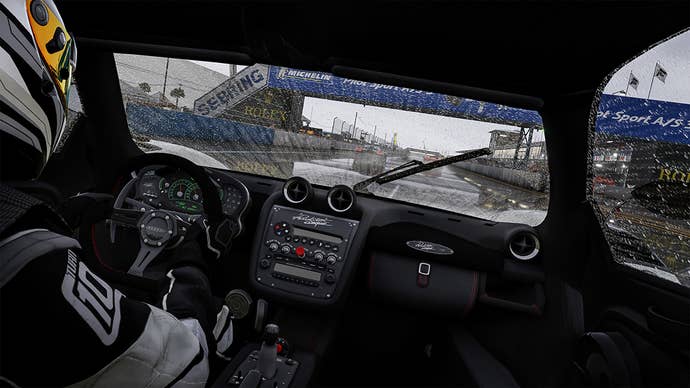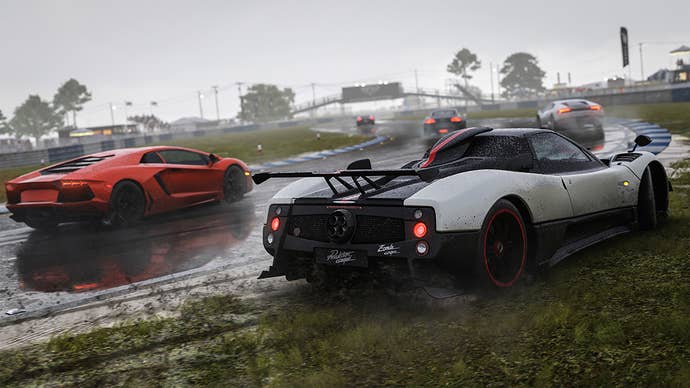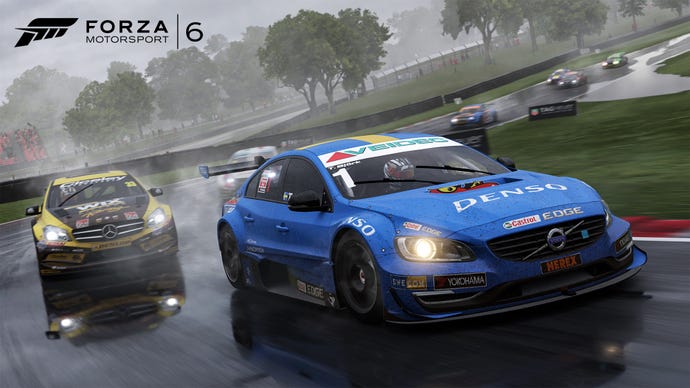Under the Hood of Forza 6 with Bill Giese
Turn 10's Creative Director explains how the game's Drivatar system works - and how wet weather racing evolved.
This article first appeared on USgamer, a partner publication of VG247. Some content, such as this article, has been migrated to VG247 for posterity after USgamer's closure - but it has not been edited or further vetted by the VG247 team.
At a recent Forza 6 preview event, I had the chance to sit down with Turn 10's Creative Director Bill Giese to talk to him about the game. I was most interested in hearing about how the Drivatar system works, and how the new wet weather racing system evolved.
First of all, let's talk about Drivatars. Is my Drivatar trained by my behavior? That is, it's not learning from the game itself, but it's learning from me?
Yes. Everything you do. The more you race, the more it's learning. There is some basic stuff we don't want to teach it, like if you're in a multiplayer game and you drive backwards – stupid stuff like that we don't want to teach the Drivatar.

That sounds like a tremendous amount of data.
It is and it isn't. When it goes up into the Azure Servers, these are cloud points that it can pull down. And it starts to develop a persona based on that, and that gets fed back down. It's not as if when you come back and pull it down from the server it's Gigs of data. It's basically calculating the persona up on the server and pushing that back down. So you'll have that each race.
If you notice with career that the way progression works, that you stay with the same car with the same AI field. That's being carried over and over. Start a new series, and it'll pull in a new field – so it doesn't happen every race.
When we heard from players coming off Forza 5 and into Forza Horizon 2, they were saying, "the Drivatars keep hitting me and beating on me." That's because the biggest swath of players are the career drivers, and they want to win at all costs. They're going to t-bone you and knock you out of my way.
And that's reflected in the way that their Drivatars drive?
Yes. With most of the people who like to play multiplayer, if you play online they're very polite. Which is weird to say about playing multiplayer online. They'll say things like "that was my line" or "watch your late braking". When they train their Drivatars, they become very precise and very clean and they're very consistent on their lines. So you take those guys and they jump into career, and they're going to have a couple of multiplayer Drivatars, and a couple of career Drivatars. We try to balance those two.
Also, players in Forza 6 can go in and limit that aggression. So it'll turn off some of the tendencies that those aggressive drivers have – like how they do braking and collisions.
When you turn off aggression, do you not get aggressive-behaving avatars.
You get less behavior that we deem aggressive.
Does it modify the actual Drivatar behavior?
No. It just won't include them.

When you're collating Drivatar data, how many points of data are you collecting?
When we moved the Drivatar pool over from Forza Horizon 2 – that's an open world game – seeing how it was doing immediately in Forza 6 was crazy. It was picking up things that we didn't think it could do, like the way it would lock up only one tire, and the way it would handle late braking.
It was cool to be able to see that. I'm excited for players to be able to train them with things like the surface temperature changes at night, or even how they handle puddles and what do they do while aquaplaning. Being able to pick up those behaviors and see how they do weeks after the launch of Forza 6.
Does the Drivatar system also inform how you categorize players in the new League system?
The temperament is loosely based on the things we pick up on Drivatars. There's essential stuff like lap times and average speed. But then the temperament side of things that is some of the aggressive stuff that we pick up on and save. So if you're a really aggressive player and like to bang up other players and beat the crap out of everyone else – you'll be in a league with those guys. You might hate it, but what leagues are really for are those guys who like to socialize. They'll be playing in leagues with players who are just like them.
There'll be a playlist that we choose that we think is right for the leagues. And there are certain things we can do for beginner leagues where we turn off collisions. Turn one is always chaotic, with a mess of stuff trying to get through that first turn. For newer players, we can turn off the collision so that they're able to go through and successfully race.
We choose tracks for each of those so that there's a theme to each league.
We look at what people mostly race. There's not a lot of D and E class cars – there's a sweet spot which is B, A and S. We can do things that the community wants.

How did the wet weather side of the game evolve?
Coming on to a new box, we definitely learned technically what it takes to make a game at 1080p and 60 frames per second. So, coming onto Forza 6, it's a heck of a lot easier. The sands aren't shifting in terms of the tech. But at the same time being able to deliver on some of the things we've always wanted to do – including night and wet. The idea of 3D puddles is something we've always wanted to do.
It's all based on your ingoing speed, and based on the friction scale of that. We have 148 different drivable surface types. That includes grass, and dirt. When you look at Sebring, that track is based on an old airfield. It has asphalt as well as older concrete and on the track in the real world they cover those transitions with this globby sealant that they put on. In our game, even that sealant has a different property. So we can set each of those uniquely, based on that – and each of those surface types is different in the wet.
The puddles that you see placed are all based on the where they are in the real world. It's been awesome to have real race drivers come in and say things like "the puddle at the bottom of the hill is exactly where water really pools up." We wanted players to feel like, "Hey I just saw an F1 race, or a Touring Challenge on EPSN, and I want to go and recreate that." We wanted to make sure it was authentic to what players see on TV.
The best and worst job at Turn 10 is the research team. They get to fly all over the world, they go to millionaire's garages and get to capture these amazing cars – one-of-a-kind cars. But at the same time, they have to scour hours upon hours of race footage and find out exactly where every single puddle is. Every single puddle we've placed is accurate based on everything we've researched.

What we specifically wanted to do with wet. We wanted to do puddles, and we thought okay, we could do reflective surfaces and make everything slippery and be done. But anyone who's driven a car through a puddle and lost traction and grip and had their heart jump, and you hear that underspray – we really wanted to nail how that feels in an authentic race scenario.
What's great is that it gives players a choice. Maybe you're on a long straight, and you can keep your line and worry about being pulled a little bit by a puddle and see how much you can fight it, or maybe you're coming up on an apex like the one at Brands Hatch that has a puddle on it, and you take the corner wide.
In racing, they call rain the great equalizer, and it's the true test of a driver's skill. It's cool to be able to recreate that.
How about the future of the series. Are you worried about hitting a ceiling?
I always think there's more that we can do. Whenever you make a game, you know there's going to be a release date and it's going to be done by that time. Leading up to that, there's always a case of we could have done this or that. I could spend five years on a game, and still probably have a bunch left that we'd want to try.
It's been really nice to develop on Xbox One, and continue to develop things like the tire model and the lighting model. I can't wait to see what the future holds for us.








